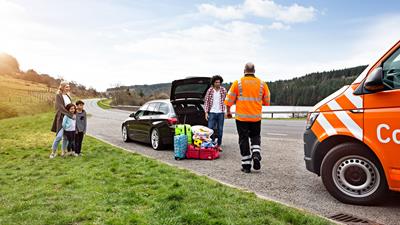
If you're planning to take your car on a road trip abroad this year, then you need to ensure you’ve got all the right documents and understand the rules after Brexit.
From green cards to international driving permits, there’s a lot to think about. So, here’s a rundown of the requirements as they stand and what you need to know.
Car insurance
All UK vehicle insurance policies include the minimum third-party cover to drive in the EU, including in Ireland, Andorra, Bosnia and Herzegovina, Iceland, Liechtenstein, Norway, Serbia and Switzerland.
However, third party insurance only covers legal liability to pay damages to someone else for injury to them, their passengers or their property. If your car is damaged or stolen, you'll have to pay for repairs or a replacement yourself, as well as any medical expenses if you're injured.
So, make sure you check your policy documents for details of what you are covered and not covered for when driving in the EU. If you are driving outside of the EU, you may need to source additional insurance.
Green cards
There were a few changes to the rules about Green cards last year.
All you need to know is that you no longer need to carry a green card when you drive in the EU, including in Ireland[1]. The same goes for Andorra, Bosnia and Herzegovina, Iceland, Liechtenstein, Norway, Serbia, or Switzerland.
You may need to carry a green card to drive in other countries, such as Morocco, Tunisia and Turkey[2]. It’s best to check the government’s travel advice for the country you’re visiting.
Driving licences, V5 and international driving permits
Wherever you go, be sure to carry your UK driving licence with you. Also remember to take your car’s V5C registration document along with your other important documents.
You may also need an international driving permit (IDP), which is a permit that allows you to drive in countries where a UK driving licence alone is insufficient. But again, best to check the government’s travel advice for the country you’re visiting.
You don’t need an IDP to visit and drive in the EU, Switzerland, Iceland or Liechtenstein. However, you might need one to drive in some EU countries and in Norway if you have a paper driving licence.
Check if you need an IDP here. If you do need to get one, they cost £5.50 and you can get one at the Post Office.
GB stickers have been replaced by UK stickers
You may or may not have seen that the old GB stickers on cars have been replaced by UK ones.
If you’re planning to drive in Spain, Cyprus or Malta, you must display a UK sticker clearly on the rear of your vehicle. You’ll also need to display a UK sticker if your number plate has:
- a GB identifier with the Union flag
- a Euro symbol
- a national flag of England, Scotland or Wales
- numbers and letters only; if your number plate includes the UK identifier with the Union flag, you do not need a UK sticker
If your car already has a GB sticker, then either remove it or cover it up.
You do not need a UK sticker or number plate to drive in Ireland.
You can buy UK stickers easily, from sites such as Amazon.
Other requirements
Here are few other steps you should take before taking to the roads in Europe. These include:
- Make sure your car is in good running order. Stay on top of the regular and easy car maintenance you can do yourself, and have your car serviced to try and prevent any unexpected issues.
- Ensure your vehicle’s tax and annual MOT are valid and up-to-date.
- Adjust your car's headlights for driving on the right-hand side of the road, so that the dipped beam doesn't dazzle oncoming drivers. This is compulsory in most European countries[3].
- If you have breakdown cover, check if you’re still covered in the country you’re travelling to, as you may need to increase your existing cover or take out a standalone European breakdown policy.
- Get the right safety equipment: in many countries, it’s compulsory to carry a warning triangle and reflective jacket[4] but rules vary by country. For example, in France, all vehicles, including motorbikes, driving in central Paris, Lyon and Grenoble now need to display a special ‘pollution sticker’[5]. For more information and to apply for a sticker, visit the French Ministry of Environment website (in English).
Go to Solved to read more about driving, the rules of the road and road safety.
[1] https://www.gov.uk/guidance/driving-in-the-eu
[2] https://www.gov.uk/driving-abroad
[3] https://www.greenflag.com/advice/driving/night
[4] https://www.rac.co.uk/drive/travel/driving-in-europe/checklist/,
[5] https://www.gov.uk/foreign-travel-advice/france/safety-and-security#road-travel


